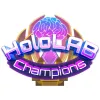
Digital Citizenship Week is October 20–24!
Join teachers worldwide to promote a healthy, positive approach to media and tech.
Take a look inside 12 images
HoloLAB Champions
Pros: Superb quality, realistic lab equipment, nicely scaffolded activities, free for education.
Cons: No free explore or custom activities; currently available only with an HTC Vive.
Bottom Line: Students can safely experiment, play, fail, succeed, and learn in this engrossing virtual chemistry lab.
Teachers can use HoloLAB Champions and the accompanying classroom guide to give their students a solid and fun set of VR chemistry activities. One of the big positives about a VR experience like this is that there's no lab equipment and no supplies to set up. Once students select an activity, the needed equipment and chemical substances appear in front of them. This may provide students with the practice of using equipment -- with zero risk to the equipment or themselves.
One of the challenges teachers are likely to encounter is a way to allow the entire class to experience HoloLAB Champions, as most schools that have access to the Vive hardware aren't likely to have several. Fortunately, it may help that some skills can be practiced in isolation (for example, measuring with a pipette), so students can spend a few minutes using only specific skills. If this isn't possible, with creative scheduling, there may be ways to meaningfully integrate the game with your chemistry class. It could fit in as part of a small-group rotation or experienced as a guided whole-class activity as students take turns with the Vive as their peers watch.
HoloLAB Champions is a virtual reality (VR) chemistry lab experience, presented in the form of a game show and currently only available for the HTC Vive. Once students are strapped in, they'll be able to choose from two main components: Chemiluminescence and Identify Unknowns. Chemiluminescence guides students in measuring and mixing liquids and solids to create glowing compounds. Identify Unknowns has students examine reference material and chemistry tools to deduce what unknown material they're performing tests on. Each sequence of activities starts with putting goggles on (safety first!) and uses the same desktop lab area throughout. At the end of each activity, students are awarded points based on their time and are penalized for spills.
The holographic host of the game show keeps things moving with a positive and humorous attitude. Although students can turn and step forward and backward slightly, there's no locomotion that would cause motion sickness. Prominent on the desk is a lab notebook that provides the procedure students need to follow and includes reference information. Generally, the font on the notebook is easy to read, but may occasionally get small enough to have to move in for a closer look. It rarely detracts from the experience, though, and never caused an issue when measuring with flasks and beakers.
HoloLAB Champions is an excellent example of what virtual reality can bring to education. Students can safely experiment, play, fail, and succeed in VR in a way that they cannot in real life. These successes and failures will certainly lead to learning that will increase competence, efficiency, and understanding in the real-world lab. Players are taught how to use Bunsen burners, tare scales, pipettes, and other common chemistry lab equipment. Measurement in the game is surprisingly accurate, with liquids even showing a meniscus caused by surface tension. Teachers will, of course, want to place special emphasis on safety in a real lab, as students can't burn or otherwise injure themselves in the virtual world.
One component that would really make HoloLAB Champions shine is if teachers could add custom activities with a greater variety of substances. This would open the door to a nearly limitless number of possible labs for students, including ones that would be too dangerous to experience in reality.





















